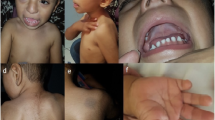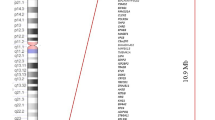Abstract
Partial 9p deletion syndrome and partial 18q duplication syndrome each have distinct clinical features. We describe the prenatal molecular cytogenetic analysis of a de novo unbalanced karyotype with deletion of 9p23-pter and duplication of 18q12.2-qter in a mild dysmorphic female fetus. Fetal ultrasonography was performed and detailed karyotype analyses were conducted using a combination of G-banding, SKY analysis and FISH with chromosome arm specific sub-telomeric DNA probes and chromosomal region specific BAC clone probes. The fetal sonography and fetal echocardiography at 17 weeks’ gestation did not reveal any anomaly while the fetus had a large unbalance karyotype of 46,XX,der(9)t(9;18) (p23;q12.2) de novo. Its external phenotype at 21 weeks appeared to have some mild dysmorphic features including hypertelorism, low-set ears, micrognathia/retrognathia, clenched hands and rocker bottom feet. These dysmorphic features are seen in the Edward syndrome but with milder degrees.


Similar content being viewed by others
References
Alfi OS, Donnell GN, Allderdice PW, Derencsenyi A (1976) The 9p- syndrome. Ann Genet 19:11–16
Bromley B, Benacerraf BR (1995) Difficulties in the prenatal diagnosis of microcephaly. J Ultrasound Med 14:303–306
Bronshtein M, Mashiah N, Blumenfeld I, Blumenfeld Z (1991) Pseudoprognathism—an auxiliary ultrasonographic sign for transvaginal ultrasonographic diagnosis of cleft lip and palate in the early second trimester. Am J Obstet Gynecol 165:1314–1316
Bronshtein M, Stahl S, Zimmer EZ (1995) Transvaginal sonographic diagnosis of fetal finger abnormalities in early gestation. J Ultrasound Med 14:591–595
Cheng PJ, Liu CM, Chueh HY, Lin CM, Soong YK (2003) First-trimester nuchal translucency measurement and echocardiography at 16 to 18 weeks of gestation in prenatal detection for trisomy 18. Prenat Diagn 23:248–251
Christ LA, Crowe CA, Micale MA, Conroy JM, Schwartz S (1999) Chromosome breakage hotspots and delineation of the critical region for the 9p-deletion syndrome. Am J Hum Genet 65:1387–1395
D’Ottavio G, Mandruzzato G, Meir YJ, Rustico MA, Fischer-Tamaro L, Conoscenti G, Natale R (1998) Comparisons of first and second trimester screening for fetal anomalies. Ann N Y Acad Sci 847:200–209
Dugoff L (2002) Ultrasound diagnosis of structural abnormalities in the first trimester. Prenat Diagn 22:316–320
Dugoff L, Thieme G, Hobbins JC (2001) First trimester prenatal diagnosis of chondroectodermal dysplasia (Ellis-van Creveld syndrome) with ultrasound. Ultrasound Obstet Gynecol 17:86–88
Economides DL (1999) Early pregnancy screening for fetal abnormalities. Ultrasound Obstet Gynecol 13:81–83
Fryns JP, Vinken L, Marien J, Van den Berghe H (1979) Partial trisomy 18q12, due to intrachromosomal duplication, is not associated with typical 18 trisomy phenotype. Hum Genet 46:341–344
Funderburk SJ, Sparkes RS, Klisak I (1979) The 9p-syndrome. J Med Genet 16:75–79
Goldstein RB, Filly RA, Callen PW (1989) Sonography of anencephaly: pitfalls in early diagnosis. J Clin Ultrasound 17:397–402
Huret JL, Leonard C, Forestier B, Rethore MO, Lejeune J (1988) Eleven new cases of del(9p) and features from 80 cases. J Med Genet 25:741–749
Li YC et al (2005) Karyotypic evolution of a novel cervid satellite DNA family isolated by microdissection from the Indian muntjac Y-chromosome. Chromosoma 114:28–38
Malinger G, Lerman-Sagie T, Watemberg N, Rotmensch S, Lev D, Glezerman M (2002) A normal second-trimester ultrasound does not exclude intracranial structural pathology. Ultrasound Obstet Gynecol 20:51–56
Meagher S, Davison G (1996) Early second-trimester determination of fetal gender by ultrasound. Ultrasound Obstet Gynecol 8:322–324
Mewar R, Kline AD, Harrison W, Rojas K, Greenberg F, Overhauser J (1993) Clinical and molecular evaluation of four patients with partial duplications of the long arm of chromosome 18. Am J Hum Genet 53:1269–1278
Razavi-Encha F, Raoul O, Lescs MC, Danan C (1985) Phenotype-karyotype correlations in dup(18q): report of a case and review. Am J Med Genet 21:591–595
Rosenmann A, Isacson M, Cohen R, Segal M, Cohen MM (1978) Partial trisomy 18(q11 leads to qter) in an infant and aborted fetus resulting from a balanced paternal translocation t(13;18)(q32:q11). Ann Genet 21:60–64
Souka AP, Nicolaides KH (1997) Diagnosis of fetal abnormalities at the 10-14-week scan. Ultrasound Obstet Gynecol 10:429–442
Summitt RL WR, Martens PA, Wilkerson PA (2001) Partial 18-trisomy due to 9-18 translocation. In: Albert S (ed) Catalogue of unbalanced chromosome aberrations in man, 2nd edn. Walter de Gruyter & Co., Berlin 30, de Gruyter, New York, p 759
Wald NJ, Hackshaw AK, Watt H (1999) Nuchal translucency and trisomy 18. Prenat Diagn 19:995–996
Wang P et al (2013) Genotype-phenotype analysis of 18q12.1-q12.2 copy number variation in autism. Eur J Med Genet 56:420–425
Young RS, Reed T, Hodes ME, Palmer CG (1982) The dermatoglyphic and clinical features of the 9p trisomy and partial 9p monosomy syndromes. Hum Genet 62:31–39
Acknowledgments
The study was supported by research grants from the National Health Research Institute, Taiwan (NHRI-EX92-9207 SI) and Bureau of Health Promotion, Department of Health, Taiwan (BH92-GC03-1) to CCL, and from National Science Council, Taiwan (NSC 91-2320-B-040-037) to YCL.
Author information
Authors and Affiliations
Corresponding author
Ethics declarations
Conflicts of Interest
The authors declare that they have no conflicts of interest.
Ethics Statement
The authors had obtained ethical committee’s approval from China Medical University Hospital, Taichung Taiwan to conduct this study.
Rights and permissions
About this article
Cite this article
Li, YC., Pan, YJ., Tsai, FJ. et al. Prenatal molecular cytogenetic analysis of a mild dysmorphic fetus with a huge unbalance karyotype involving partial 9p deletion and partial 18q duplication. Genes Genom 38, 53–57 (2016). https://doi.org/10.1007/s13258-015-0340-z
Received:
Accepted:
Published:
Issue Date:
DOI: https://doi.org/10.1007/s13258-015-0340-z




